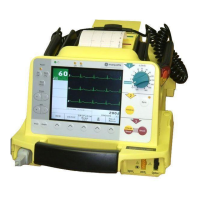Semiautomatic Defibrillation
227 490 02-C Marquette Responder® 3000 31
Some Basic Facts
On the control panel of the semiautomatic
defibrillator there is one additional button:
Analyse
.
In the semiautomatic mode, an arrhythmia
detection program scans the patient's ECG to
check whether or not a shockable rhythm exists. If
a shockable rhythm is found, the unit recommends
defibrillation and automatically starts charging. In
this operating mode, conventional control of the
defibrillator is not possible (charging cannot be
initiated manually).
The semiautomatic mode is thus suitable for
persons who are not legally permitted to utilize a
manual defibrillator (e.g. persons with insufficient
knowledge of ECG analysis).
Observe the recommendations published by the
AHA (American Heart Association) and the ERC
(European Resuscitation Council).
In the semiautomatic mode, the defibrillator will
start analyzing the ECG when the
button is
pressed. If the analysis algorithm detects ven-
tricular flutter (> 120 bpm), ventricular fibrillation
or ventricular tachycardia with a deviating QRS
morphology, the defibrillator
−
displays a message,
−
starts charging, and
−
informs the user when it is ready to deliver the
shock.
The energy selector must be set to the "Autoseq"
position, where the defibrillator automatically
sequences the energy levels preset for the first
three shocks. The factory default setting is the
sequence recommended by AHA/ERC: 200 J,
200 J, 360 J. You are free, however, to select the
energy levels for the Autosequence shocks from
the following values: 150 J, 200 J, 300 J, 360 J.
If you do not set the energy selector to "Autoseq",
an error message will be displayed. The message is
cleared when
−
you select "Autoseq" or
−
switch to the manual operating mode.
It is recommended to acquire the ECG signal for
analysis via the disposable defibrillation pads.
ECG electrodes can be used as well. Paddles
should not be used because they are likely to
induce artifact.
Note
The analysis algorithm only responds to shockable
arrhythmias.
Literature (at the time of printing)
Guidelines for Resuscitation, European Resuscita-
tion Council (1998), ISBN 0-444-82957-1
Handbook of Emergency Cardiac Care, American
Heart Association (1996), ISBN 0-8151-0885-0
"The Arrhythmia Detection Program" in the
appendix of this manual.

